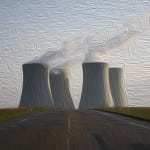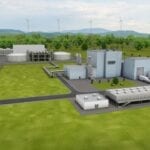The Department of Energy (DOE) on Oct. 7 notified Congress that it has chosen recipients for its Advanced Reactor Demonstration Program (ARDP) and will make its selections public “next week.”
The ARDP program, which the DOE officially launched on May 14, will essentially focus DOE and non-federal resources (through cost-shared agreements with industry) to enable actual construction of advanced nuclear reactors over the near- and mid-term. The program leverages $230 million in Congressionally appropriated Fiscal Year 2020 funding to launch the initiative.
The DOE kicked off the process in May through a funding opportunity announcement (FOA) with a $4 billion award ceiling. The FOA comprises two separate approaches that could support up to seven advanced reactor projects and subsidize their adoption over the next 15 years.
Under the first pathway—whose recipients will likely be announced next week—the Office of Nuclear Energy will provide $160 million in the first year of funding through cost-shared partnerships to help domestic private industry demonstrate two advanced nuclear reactors that can be operational within the next five to seven years.
The second pathway comprises “risk reduction for future demonstration awards,” which support two to five additional “diverse” advanced reactor designs that have a “commercialization horizon that is approximately 5 years longer than the Advanced Reactor Demonstrations.”
However, the FOA also identified a third pathway (described in H.R. 1865, Advanced Reactor Concepts – 20) to bolster development of “at least two new public-private partnership awards focused on advancing reactor designs toward the demonstration phase.” These projects would have a “commercialization horizon that is approximately 5 years longer than the Risk Reduction for Future Demonstration awards,” it said.
Who’s in the Running?
The application submittal period for the Advanced Reactor Demonstration FOA closed on Aug. 19.
POWER has so far confirmed that a consortium comprising GE Hitachi Nuclear Energy (GEH), TerraPower, and Bechtel have submitted a joint proposal for the Natrium, a 345-MWe sodium fast reactor (SFR) with a molten salt energy storage system, to the ARDP FOA. GEH, however, declined to comment about whether it had submitted a proposal for its BWRX-300 reactor design.
TerraPower, whose board is chaired by Bill Gates, on Sept. 15 notably announced it would team with Centrus Energy to establish commercial-scale, domestic production capabilities for high-assay, low-enriched uranium (HALEU). Centrus, formerly known as U.S. Enrichment Corp. (USEC) (originally a government corporation), has a three-year $115 million (80%-20% cost-shared) contract that will allow it to deploy a small cascade of 16 AC-100M centrifuges at the American Centrifuge Plant in Piketon, Ohio, to demonstrate HALEU production by 2022. On Oct. 8, TerraPower also unveiled Bechtel as the Natrium’s plant design, licensing, procurement, and construction partner as part of the ARDP proposal. Along with GEH, the proposal’s other backers include PacifiCorp, Energy Northwest, and Duke Energy.
Finally, in an Oct. 2 webinar hosted by the Fast Reactor Working Group, TerraPower Senior Vice President of Innovations Jeff Latkowski said his company has also submitted a risk reduction proposal for its Molten Chloride Fast Reactor (MCFR) technology. “We’ve been working on this for about a year with folks at [Idaho National Laboratory’s National Reactor Innovation Center] and elsewhere,” he said. “This would be a plutonium-fueled machine to specifically demonstrate the very low beta that we get with both the plutonium and as well with a molten salt, where … the fuel is moving outside of the core, so you have fewer neutrons to control.”
Ultra Safe Nuclear Corp. (USNC) on Oct. 8 also confirmed to POWER that it submitted an ARDP proposal. The Seattle-based company this June, notably, formed a joint venture, Global First Power, with Ontario Power Generation to build, own, and operate a proposed Micro Modular Reactor (MMR) high-temperature gas-cooled reactor (HTGR) demonstration at the Atomic Energy of Canada Limited’s Chalk River Laboratories site in Ontario. In another noteworthy, recent move, USNC on Sept. 1 established a new facility in Salt Lake City, Utah, to support development of its proprietary Fully Ceramic Micro-encapsulated (FCM) fuel. Materials developed at the new facility will be used in USNC’s MMRs—including the 15-MW reactor currently in the advanced licensing stage at Chalk River—as well as in other nuclear reactors, “including gas-cooled reactors, light water reactors, CANDU reactors, and molten salt cooled reactors,” it said.
Also in the running is Oklo, developer of the 1.5-MW Aurora micro-reactor, which earlier this year submitted the first-ever combined license application (COLA) for an advanced non-light water reactor (LWR) to the Nuclear Regulatory Commission (NRC). However, Oklo officials told POWER that the ARDP’s terms may prove limiting to its innovative developmental model, which is why the company also sought a risk reduction award.
The Tennessee Valley Authority (TVA) in September also confirmed it submitted a proposal to the FOA, possibly for an installation at its Clinch River Nuclear site in Tennessee, for which it received the NRC’s approval for an early site permit for two or more small modular reactor (SMR) modules (of up to 800-MWe) at the site last December. However, TVA declined to provide details. “At this time, details of the proposal are business sensitive and proprietary in nature,” the utility told POWER.
The Next-Gen Nuclear Race Growing More Competitive
POWER has reached out to several other advanced reactor developers to confirm participation in the ARDP and will provide updates here as they are received. However, it is clear enthusiasm for the program in the burgeoning industry. One reason is that the space is growing increasingly competitive, as a September 2020 report from the International Atomic Energy Agency’s Advanced Reactors Information Systems suggests. Today, more than 18 advanced reactor designs are in different stages of development in the U.S.
Among domestic water-cooled land-based SMRs are: NuScale; GEH’s BWRX-300; Holtec’s SMR-160; Westinghouse’s W-SMR; and BWX Technology’s mPower.
The list of U.S.-developed high-temperature gas-cooled (HTGR) SMRs includes: X-energy’s Xe-100, StarCore, and Framatome’s SC-HTGR. Among larger fast neutron spectrum reactors are: TerraPower and GEH’s Natrium, General Atomic’s Energy Multiplier Module, Westinghouse’s LFR, and Argonne National Laboratory’s SUPERSTAR reactor. And among larger molten salt reactors are Flibe Energy’s LFTR; Kairos’ KP-FHR; and Elysium’s MCSFR.
These lists also include four notable micro-reactor designs: Oklo’s 1.5-MW Aurora (a fast reactor); Westinghouse’s 2-MW eVinci (a heat-pipe reactor); USNC’s 5-MW MMR (an HTGR); and Radiant‘s 1.2-MW micro-reactor (a portable, micro-HTGR).
The Need for a Diversity of Designs
According to national think tank Third Way, to ensure the ARDP will effectively establish commercially viable advanced reactor technologies, “it is crucial that the Department chooses to develop two advanced reactor designs that are cost-competitive, attractive to utilities, and able to flexibly integrate into a renewable-heavy grid.” This is why the DOE “should select at least one advanced, non-light water reactor for demonstration,” as Jackie Kempfer, Third Way senior policy advisor and Josh Freed senior vice president of the think tank’s Climate and Energy Program wrote in an August memo.
Over the past decade, Congress has appropriated more than $700 million to help license and develop SMR designs, the memo notes. But so far, little progress has been made. Near-term prospects for SMR deployments hang on NuScale Power, which has plans to supply 12 modules—each rated at 60 MWe—for the Carbon Free Power Project at an Idaho National Laboratory site for potential customer Utah Associated Municipal Power Systems (UAMPS).
Kempfer noted in an interview with POWER that though NuScale was not eligible for the ARDP, a smaller, 50-MWe module version of NuScale’s design on Aug. 28 became the first SMR to receive a final safety evaluation report (FSER) from the Nuclear Regulatory Commission (NRC). UAMPS now appears to be awaiting a possible $1.4 billion in federal funding from the DOE to put the project on track for first-unit completion by 2029.
“Despite this significant taxpayer support, SMRs appear to be facing some of the challenges that have confronted the development of traditional large light water reactors,” the experts at Third Way said. “They have run into scheduling delays and cost increases that, while unsurprising in a new and complex technology, have narrowed the gap between SMRs and more advanced designs. This means it no longer makes sense to spend the lion’s share of new federal funding on designs that constitute a smaller, modernized version of light water technology.”
The ARDP has been an open opportunity “to diversify the U.S. nuclear ecosystem so that the future of the advanced nuclear industry does not hinge on one technology,” the experts suggested. “Therefore, we believe that one of the two ARDP demonstrations should be a non-light water utility-scale reactor that could bring significant amounts of carbon-free power onto the grid.”
The DOE’s Office of Nuclear Energy, for its part, on Oct. 6 promoted three advanced reactor systems that it suggests “could be operational within a decade.” These include sodium-cooled fast reactors, very high temperature reactors, and molten salt reactors.
Nuclear is going to look 👀 a lot different in the near future. Here’s a sneak peek at new reactor designs that could be operational within the decade. https://t.co/7yQMXCPGOH
— Office of Nuclear Energy (@GovNuclear) October 6, 2020
—Sonal Patel is a POWER senior associate editor (@sonalcpatel, @POWERmagazine).
Updated (Oct. 8): Adds that Oklo and USNC confirmed submissions to the ARDP FOA. (Oct. 10): Adds details about TerraPower’s partnerships with Bechtel, Centrus, and its risk reduction proposal for the MCFR. (Oct. 13): Adds Radiant to list of micro-reactors.
Correction (Oct. 22): This article erroneously reported, citing another media source, that project costs for the UAMPS’ Carbon-Free Project will increase. A clarification will be published here.










